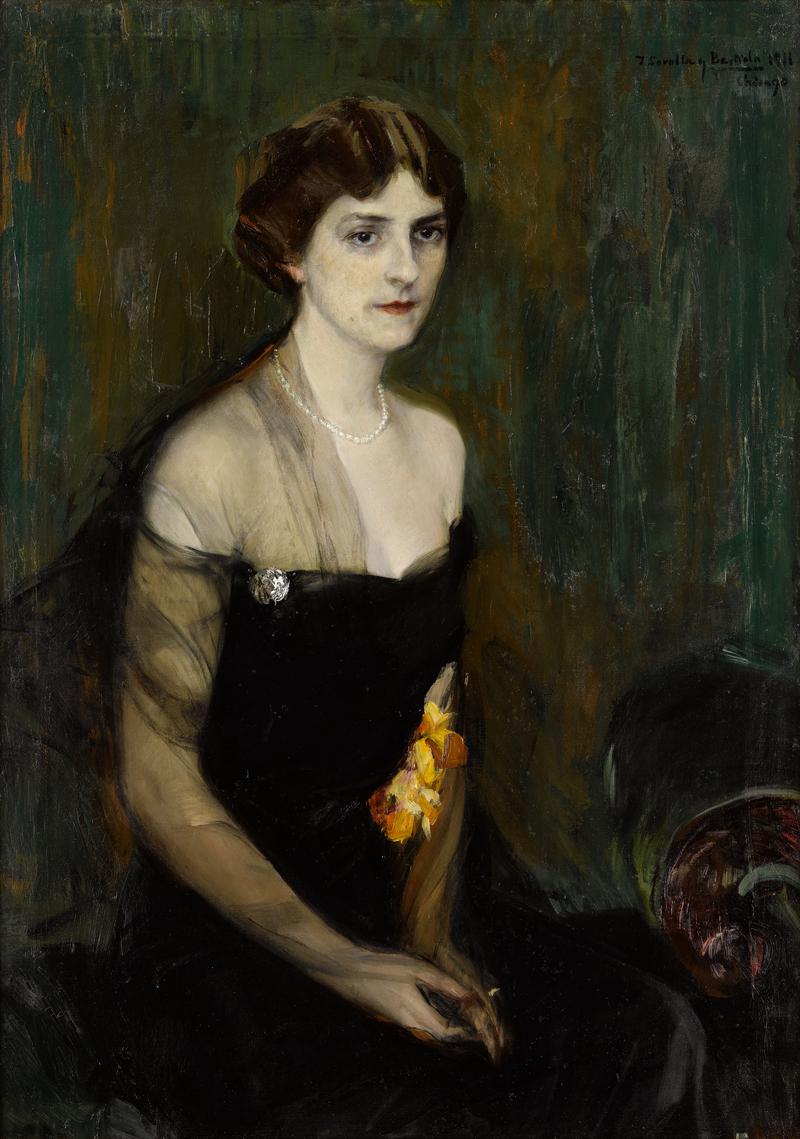Portrait of Mrs Orville E. Babcock

Mrs Orville Babcock was one of a series of portrait commissions undertaken by Sorolla during his stay in Chicago in the early months of 1911. Having first visited New York to present the Hispanic Society of America with some of his new works, Sorolla travelled to Chicago in February, to attend the opening of his major solo exhibition, where the 161 works were viewed by over 100,000 visitors.
During this time, Sorolla painted several portrait commissions, four of which, including this work, were included in an exhibition of Portraits at the Art Institute of Chicago the following year.
The sitter is presumably the wife of Orville A. Babcock Junior. Orville Elias Babcock Senior (1835–1884) was an American Civil War General in the Union Army and served as Private Secretary to President Ulysses S. Grant.
An absolutely stunning exhibition of Sorolla’s work was held at The National Gallery, London entitled Spanish Master of Light, 18 March – 7 July 2019.
Joaquín Sorolla y Bastida studied at the Escuela de Bellas Artes in Valencia and in the studio of Gonzalo Salva. He was influenced by the two Valencian painters Bernardo Ferrandiz and Francisco Domingo Marqués, but by far his strongest influence was Ignacio Pinazo Camarlench, as can be seen in Sorolla’s work prior to 1885. He obtained a travel scholarship to Italy and worked in Rome and Assisi from 1884 to 1888, where he received advice from Francisco Pradilla y Ortiz. He settled in Madrid, travelling regularly to France and visiting Paris frequently in order to study the work of the Paris School with whom he felt an affinity. He married Clotilde García del Castillo in Spain. He became paralysed in one side of his body and gave up painting in June 1920.
Three aspects characterised Sorolla’s work: a constant preoccupation with light, painting in the open air (to which he was introduced by Gonzalo Salva) and the quiet development of controlled drawing. He painted a wide range of subjects, from historical compositions such as The Death of Valentino to religious paintings such as: The Burial of Christ (now destroyed); St Claire; The Kissing of the Relic; St Sebastian; portraits: Elena; Mother; Clerk of the Court; Doctor Simarro in His Laboratory; Alfonso XIII in Hussar’s Uniform; genre scenes: Sewing Sails; Return from Fishing; Bathing; View of Spain; Valencia; and landscapes: Sea and Rocks at San Esteban; The Asturias; Toledo.
In 1911, Sorolla received a commission for a series of decorative panels illustrating The Provinces of Spain, for the library of the Hispanic Society of America in New York, a monumental work 190 feet (58 metres) wide, on which he worked for nearly six years. From 1917 to 1918, the themes of the countryside and the beach, which had been close to the artist’s heart, made way for the garden. Sorolla completed several different versions of the gardens of the Alcázar in Seville and the Alhambra in Granada.
From observation of his native Valencia, Sorolla learned to render, and use for other ends, the hazy dust of the light and the vivid colours produced by the shadows. His passion for translating nature and light onto the canvas just as he saw it allied him firmly with the Impressionists. Sorolla’s own success at home ensured the success of the other Impressionists in Spain and heralded the fall from grace of traditional studio painting. His technique is in many ways similar to that of his friend Zorn. He was particularly skilled in transposing the effect of light on water, the transparency of water on sand and the dazzling streams of light flowing over the naked bodies of bathers in the open air.



